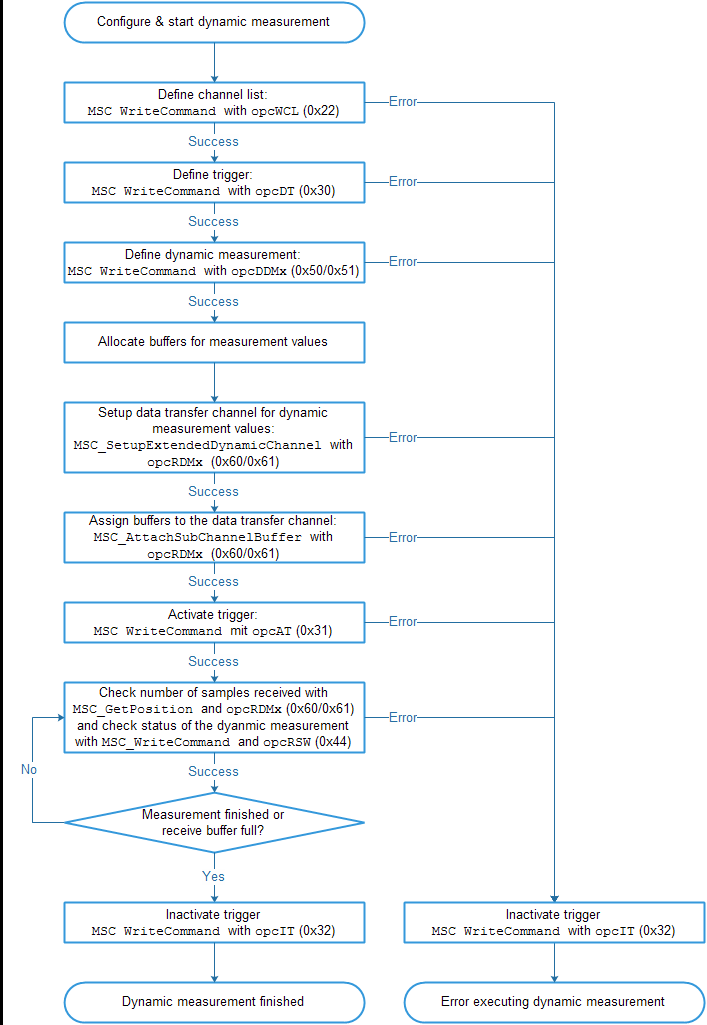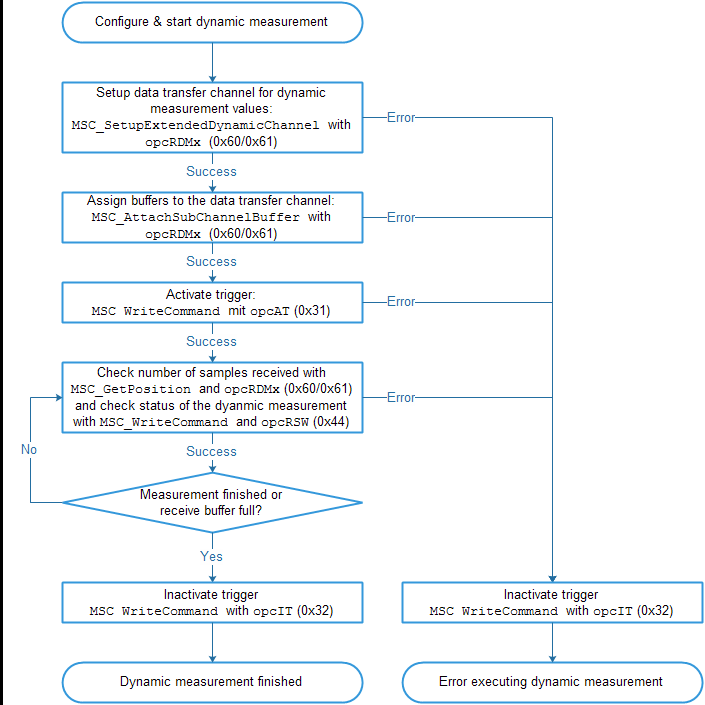
Irinos Measurement System
A dynamic measurement is always limited in time. It is usually started before the beginning of a dynamic measurement process (e.g. before starting a motor). The maximum time allowed is 1 hour, which is just a theoretical value. Usually it lasts less than a minute.
There are two types of dynamic measurement:
oUsing time-triggered dynamic measurement, all selected measurement channels are sampled simultanesouly in equidistant time-spans. It is possible to sample 10.000 values/s per channel.
oUsing position-triggered dynamic measurement, all measurement values are sampled simultaneously in pre-defined position-distances. This requires a measurement channel, which provides the position information. For example an incremental encoder can be used for concentricity measurement with 360 measurement values / rotation.
The measurement channel, which provides the position information, is internally sampled at 1.000 Hz.
Position-triggered measurement is a good choice, if the speed of the work piece varies during measurement, e.g. if a rotary disc is rotated by hand or with an uncontrolled motor.
Modern servo drives usually have a very accurate speed control. Thus constant position- or angle-distances can be achieved. Therefore often time-triggered measurement can be used in such applications.
Before starting a dynamic measurement, it must be defined. The following figure shows the typical steps for configuring, starting, running and finishing a dynamic measurement:

Steps for performing a dynamic measurement
a)Using the function MSC_WriteCommand together with the opcode opcWCL (0x22), a channel list is transferred to the Irinos-System.
The channel list contains a list of all measurement channels, which shall be used for the dynamic measurement. 32 channels can be used at maximum.
b)A trigger is defined using the function MSC_WriteCommand together with the opcode opcDT (0x30) The trigger definition contains:
oWhether it is a time- or position-triggered dynamic measurement.
oThe name of the measurement channel, which provides the position information (only used for position-triggered dynamic measurement).
oThe start time/position of the dynamic measurement.
oThe time-period respectively position-distance between two measurement values.
oThe end time/position of the dynamic measurement (optionally).
c)The dynamic measurement itself is defined using the function MSC_WriteCommand together with the opcode opcDDMx (0x50/0x51). The definition contains:
oThe channel list, which shall be used for the dynamic measurement.
oThe trigger configuration to be used for the dynamic measurement (trigger number).
oThe maximum number of sampled measurement values per channel.
d)A data transfer channel for reading the dynamic measurement values is set up using the function MSC_SetupExtendedDynamicChannel together with the opcode opcRDMx (0x60/0x61). This data transfer channel is required to transfer the measurement values from the Irinos-System to the PC / application.
e)A buffer for storing the dynamic measurement values must be provided to the MscDll using the function MSC_AttachSubChannelBuffer together with the opcode opcRDMx (0x60/0x61).
For each measurement channel a buffer must be allocated and provided to the MscDll via this function. If for example 5 measurement channels are used, then 5 buffers must be allocated and assigned to the MscDll via this function.
The size of all buffers is identical. It depends on the maximum number of samples, which can be expected for the dynamic measurement. Similar to the static measurement, all measurement values are stored as 32 bit integer values.
f)The dynamic measurement is started using the function MSC_WriteCommand together with the opcode opcAT (0x31). This will start the trigger, which is the same as starting the dynamic measurement.
g)The function MSC_GetPosition together with the opcode opcRDMx (0x60/0x61) returns the number of measurement values already received.
Using the function MSC_WriteCommand together with the opcode opcRSW (0x44) provides a statusword with status information about the dynamic measurement. One of the bits for example is set, if the dynamic measurement is finished.
Typically one of these functions is called cyclically, while a dynamic measurement is active.
It depends on the application, when a dynamic measurement is defined as finished. The safest way is using the Bits of the statusword.
h)It is recommended do inactivate the trigger after the dynamic measurement using the function MSC_WriteCommand together with the opcode opcIT (0x32). This ensures that a newly defined dynamic measurement does not start prior to the defined start time.
If an identical dynamic measurement is repeated, it is possible to omit the steps a) to d). The follwing figure shows the steps for repeating a dynamic measurement:

Steps for repeating a dynamic measurement (with identical configuration)
